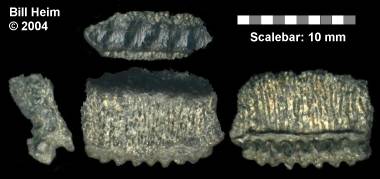| |

Mobulid rays appear in the Paleogene as evidenced by Burnhamia and Archaeomanta. This family would eventually flourish in the Mio-Pliocene. One of the important genera is Plinthicus, which first appears in Oligocene deposits. The Belgrade teeth compare well with Plinthicus stenodon specimens found in the Chandler Bridge, Old Church, Calvert and Pungo River formations.
The Plinthicus dentition is made up of multiple files, laterally expanded in medial positions and becoming less elongated laterally. Compared to the roots, the crowns are very high and lingually directed. The labial and lingual faces bear strong ridges but the occlussal surface is flat and generally reflects little wear. When attempting to differentiate these teeth from other mobulids such as Paramobula, it is important to note that the occlussal surface of Plinthicus is much more labio-lingually expanded in Plinthicus.
 |
Fig. 1 Plinthicus stenodon lateral tooth
Belgrade Formation: Late Oligocene, North Carolina |
|